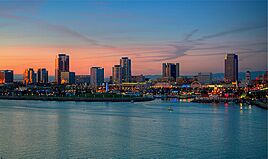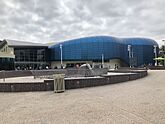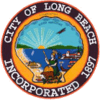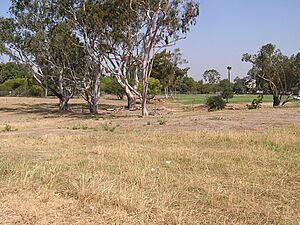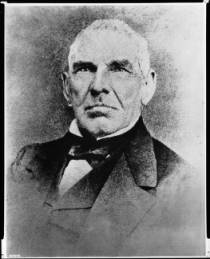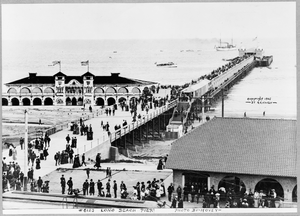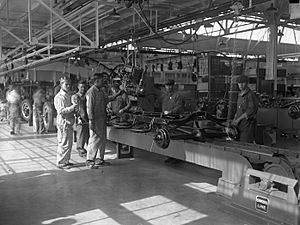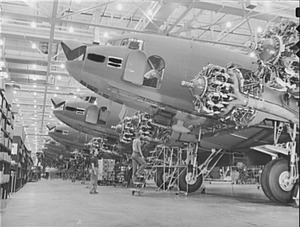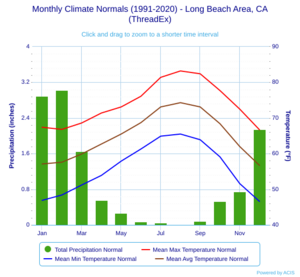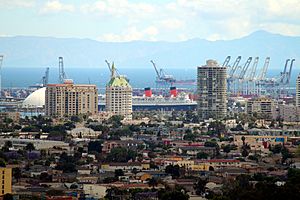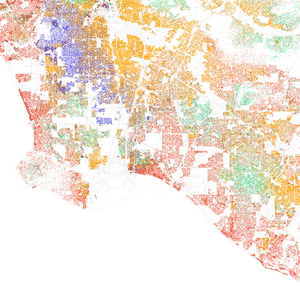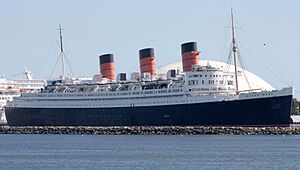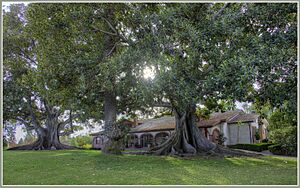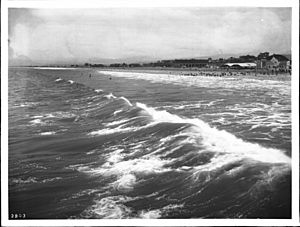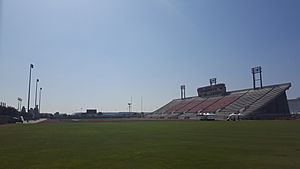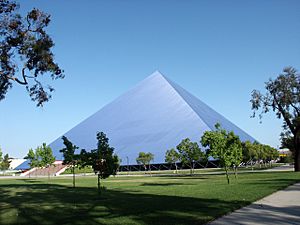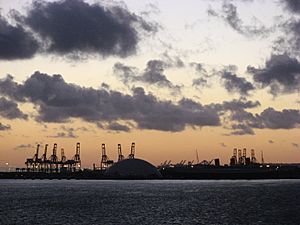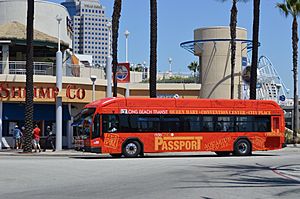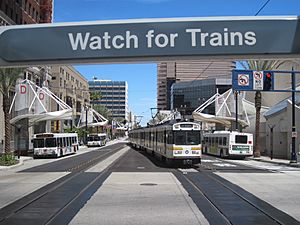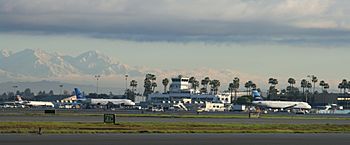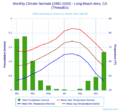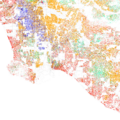Long Beach, California facts for kids
Quick facts for kids
Long Beach, California
|
|||
|---|---|---|---|
|
Lions Lighthouse
Retired RMS Queen Mary
|
|||
|
|||
| Nickname(s):
"Aquatic Capital of America"
|
|||
| Motto(s):
"The International City"
|
|||
| Country | United States | ||
| State | California | ||
| County | Los Angeles | ||
| CSA | Los Angeles-Long Beach | ||
| MSA | Los Angeles-Long Beach-Anaheim | ||
| Incorporated | December 13, 1897 | ||
| Government | |||
| • Type | Council-manager | ||
| Area | |||
| • City | 80.35 sq mi (208.10 km2) | ||
| • Land | 50.70 sq mi (131.32 km2) | ||
| • Water | 29.64 sq mi (76.77 km2) 2.22% | ||
| Elevation | 52 ft (16 m) | ||
| Population
(2020)
|
|||
| • City | 466,742 | ||
| • Rank | 44th in the United States 7th in California |
||
| • Density | 9,205.96/sq mi (3,554.23/km2) | ||
| Time zone | UTC-08:00 (Pacific) | ||
| • Summer (DST) | UTC-07:00 (PDT) | ||
| ZIP Codes |
90801–90810, 90813–90815, 90822, 90831–90835, 90840, 90842, 90844, 90846–90848, 90853, 90895, 90899
|
||
| Area code | 562 | ||
| FIPS code | 06-43000 | ||
| GNIS feature IDs | 1652747, 2410866 | ||
Long Beach is a big city on the coast in southern Los Angeles County, California. It's one of the largest cities in the United States, with over 450,000 people living there in 2022. Long Beach is the 7th biggest city in California and the 2nd biggest in Los Angeles County.
The city was officially started in 1897. It's about 20 miles (32 km) south of downtown Los Angeles. Long Beach is famous for its busy Port of Long Beach, which is one of the biggest shipping ports in the world. The city also sits on top of an oilfield, meaning there are oil wells both on land and offshore.
Long Beach has many fun places to visit, like the famous RMS Queen Mary ship and the Aquarium of the Pacific. It also hosts exciting events such as the Grand Prix of Long Beach, a big car race, and the Long Beach Pride Festival. California State University, Long Beach, a large university, is also located here.
Contents
- Discovering Long Beach's Past
- Long Beach's Location and Weather
- Understanding Long Beach's Environment
- People and Communities of Long Beach
- Long Beach's Economy and Jobs
- Arts and Culture in Long Beach
- Parks and Outdoor Fun in Long Beach
- Sports and Recreation in Long Beach
- How Long Beach Works
- Getting Around Long Beach
- Media and News in Long Beach
- Notable People from Long Beach
- Long Beach's Sister Cities
- Images for kids
- See also
Discovering Long Beach's Past
Early People of Long Beach
For over 10,000 years, Native American groups lived in coastal Southern California. When Spanish explorers arrived in the 1500s, the main group was the Tongva people. They had several villages in the area that is now Long Beach.
Two important coastal villages were Ahwaanga and Povuu'nga. Povuu'nga was a special place for the Tongva. It was a trading center and a fishing hub. It also had deep spiritual meaning as the place where their people believed their lives began.
Spanish and Mexican Influence
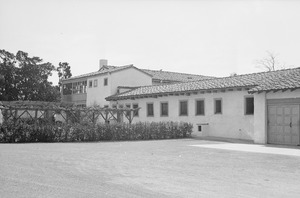
In 1784, the King of Spain gave a large piece of land called Rancho Los Nietos to a Spanish soldier named Manuel Nieto. This huge ranch was later divided into smaller ranches, including Rancho Los Cerritos and Rancho Los Alamitos.
By 1805, many Tongva villagers from Povuu'nga were moved to Mission San Gabriel. They were brought there for religious teaching and to work.
In 1843, Juan Temple bought Rancho Los Cerritos. He built the "Los Cerritos Ranch House", which is still standing today and is a National Historic Landmark. Temple became very successful with his cattle ranch.
Growth and Development of Long Beach
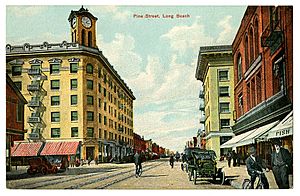
After California became part of the United States, Juan Temple sold Rancho Los Cerritos in 1866 to a sheep-raising company. Jotham Bixby, known as the "Father of Long Beach," managed the ranch. In 1880, part of the land was sold to William E. Willmore, who tried to create a farming community called Willmore City. This plan didn't work out.
A group from Los Angeles then bought the land and renamed the community to Long Beach.
Becoming a City: Long Beach Incorporated
Long Beach officially became a city in 1897. It grew as a fun seaside resort town. The Pike was a famous amusement area on the beach from 1902 to 1969. It had food, games, and exciting rides like the Cyclone Racer roller coaster.
Over time, the oil industry, Navy facilities, and the port became very important to the city. In the 1950s, many people from the Midwest moved to Long Beach.
Oil was found in 1921 on Signal Hill, which soon became its own city. The Long Beach Oil Field became one of the most productive oil fields in the world in the 1920s. Later, the even larger Wilmington Oil Field was developed in 1932. This made Long Beach famous as an oil town.
A strong earthquake in 1933 caused a lot of damage and killed 120 people. Many school buildings were badly damaged.

The Ford Motor Company built a factory in Long Beach in 1929. They built cars like the Ford Model A there. This factory continued making cars until 1960.
In 1938, the Carmelitos Housing Project was built in North Long Beach. It was Southern California's first affordable housing complex.
Long Beach During World War II and Modern Times
Long Beach, with its important port, had a strong connection to the U.S. Navy even before World War II. During the war, the city was part of the Battle of Los Angeles.
Long Beach's population grew a lot during and after the war. Many people moved there for jobs in wartime factories and to find homes.
The Douglas Aircraft Company had its biggest factory in Long Beach. It built many planes for the war, including transport planes and bombers. Later, it built famous passenger planes like the Douglas DC-8 and McDonnell Douglas DC-9. Douglas merged with McDonnell Aircraft Company in 1967, and then with Boeing in 1997. Boeing continued to build large transport planes in Long Beach until 2015.
Long Beach's Location and Weather
Where is Long Beach?
Long Beach is about 21 miles (34 km) south of downtown Los Angeles. The city covers about 80.35 square miles (208.10 km2). A large part of this area, about 29.64 square miles (76.77 km2), is water. Interestingly, Long Beach completely surrounds the smaller city of Signal Hill.
What's the Climate Like in Long Beach?
Long Beach has a warm climate with hot summers and mild winters. Most days are sunny, just like in other parts of Southern California. Temperatures at the Long Beach Airport are usually warmer than right by the ocean.
In summer, you might see low clouds and fog in the mornings. This usually clears up by the afternoon. A cool breeze from the ocean often keeps temperatures comfortable.
The average temperature in Long Beach is about 64.9°F (18.3°C). August is the hottest month, averaging 74.3°F (23.5°C). December is the coolest, averaging 56.7°F (13.7°C). Long Beach usually has about 23 days a year where the temperature goes above 90°F (32°C).
Most of the rain in Long Beach happens in the winter months, from December to March. Summers, especially August, are usually very dry.
Understanding Long Beach's Environment
Air and Water Quality
Long Beach faces challenges with air pollution. Because it's close to the busy ports of Los Angeles and Long Beach, winds often carry pollution from ships and trucks directly into the city. This pollution comes from things like bunker fuel used by ships and diesel from trucks. This means the air can be less healthy in Long Beach compared to other parts of Los Angeles.
The water quality in the Long Beach part of San Pedro Bay can also be a concern, especially after it rains. The Los Angeles River flows into the bay, bringing urban runoff from the entire Los Angeles area. This runoff can carry trash, chemicals, and germs into the water. A large wall called the Federal Breakwater keeps the waves out, but it also means the water doesn't get cleaned out by tides as easily. Because of this, the water in Long Beach is sometimes not safe for swimming for a few weeks each year.
Local Wildlife and Nature
Historically, the Long Beach area had many different natural environments, with coastal plants being common.
People and Communities of Long Beach
Long Beach is a very diverse city. Many people have moved here from other countries. The top five countries of origin for immigrants are Mexico, the Philippines, Cambodia, El Salvador, and Vietnam.
The most common languages spoken in Long Beach, besides English, are Spanish, Khmer, and Tagalog. There are large communities of Mexican American, Cambodian, and Filipino Americans in the city.
| Historical Demographic profile | 2019 | 2010 | 1990 | 1970 | 1950 |
|---|---|---|---|---|---|
| White | 52.3% | 46.1% | 58.4% | 91.8% | 97.4% |
| —Non-Hispanic Whites | 28.4% | 29.4% | 49.5% | 86.2% | N/A |
| Black or African American | 11.3% | 13.5% | 13.7% | 5.3% | 1.7% |
| Hispanic or Latino (of any race) | 43.2% | 40.8% | 23.6% | 6.0% | N/A |
| Asian | 11.8% | 12.9% | 13.6% | 1.9% | 0.7% |
Population in 2022
In 2022, there were about 451,319 people living in Long Beach. The city had about 170,965 households. The population density was about 8,907 people per square mile (3,439 people per square kilometer).
About 20% of the population was under 18 years old. The average age in the city was 36.7 years.
Population in 2010
The 2010 census showed Long Beach had 462,257 people. About 46.1% were White, 13.5% Black or African American, and 12.9% Asian. About 40.8% of the people were Hispanic or Latino.
Long Beach has the largest ethnic Cambodian population outside of Asia, with about 20,000 people.
Population in 2000
As of the 2000 census, Long Beach had 461,522 people. The city has changed a lot since the 1950s, when most of its residents were of European background. Since the mid-1900s, many Asian and Latin American immigrants have moved to Long Beach.
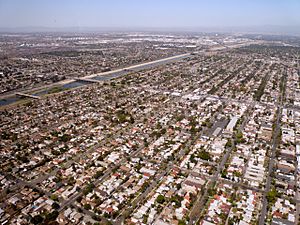
In 1942, during World War II, Japanese Americans living in coastal areas, including Long Beach, were moved to internment camps. This happened under a special order from President Franklin D. Roosevelt.
Long Beach's Economy and Jobs
The economy of Long Beach has changed over the years. Oil production was once a huge part of it and still helps fund the city. Long Beach was also a Navy town for many years.
The aerospace industry was very important. Douglas Aircraft Company (which later became part of Boeing) had factories at the Long Beach Airport. They built planes for World War II and later passenger jets. Boeing continued to build large transport planes here until 2015.
Many companies have their headquarters or major offices in Long Beach. These include Epson America, Pioneer Electronics, and SCAN Health Plan. Molina Healthcare, a healthcare program, is also based here.
Major Employers in Long Beach
| # | Employer | Employees (2022) | Industry | HQ |
|---|---|---|---|---|
| 1 | Long Beach Unified School District | 12,049 | Education | |
| 2 | City of Long Beach | 5,395 | Government | |
| 3 | Long Beach Memorial Medical Center | 4,950 | Healthcare | |
| 4 | VA Long Beach Healthcare System | 3,524 | Healthcare | |
| 5 | California State University, Long Beach | 3,336 | Education | |
| 6 | Long Beach City College | 3,321 | Education | |
| 7 | Boeing | 2,019 | Aerospace | |
| 8 | St. Mary Medical Center | 1,547 | Healthcare | |
| 9 | CSULB Research Foundation | 1,261 | R&D | |
| 10 | Molina Healthcare | 1,119 | Healthcare |
The Port of Long Beach is the second busiest seaport in the United States. It handles over $140 billion worth of trade every year. The port supports over 30,000 jobs in Long Beach and many more across California and the U.S.
Arts and Culture in Long Beach
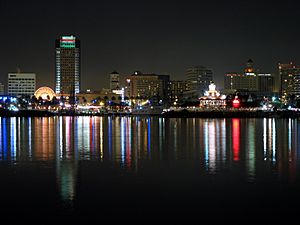
Art in the City
The Long Beach Museum of Art is located in a historic home. Long Beach also has the Museum of Latin American Art (MOLAA), which is the only museum in the western U.S. focused on modern and contemporary Latin American art.
The Pacific Island Ethnic Art Museum (PieAM) is Long Beach's newest museum, opened in 2010.
Long Beach is known for its street art and murals. One of the largest murals in the world, by artist Wyland, is on the outside of the Long Beach Sports Arena.
Music Scene
The Bob Cole Conservatory of Music at CSULB offers many classical, jazz, and world music concerts. The Long Beach Symphony also plays classical and pop concerts.
Long Beach Opera is the oldest professional opera company in the area.
Long Beach hosts several music festivals throughout the year, including reggae, Cajun & Zydeco, jazz, and blues festivals. The Long Beach Municipal Band, started in 1909, is the longest-running city-supported band in the country.
Many famous musicians and bands come from Long Beach, such as Snoop Dogg, Sublime, and Vince Staples.
Theater and Performances
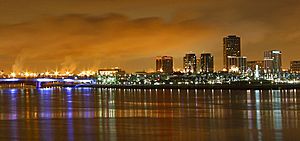
Long Beach has several theater companies. Musical Theatre West performs at the Carpenter Performing Arts Center. International City Theatre puts on plays and musicals at the Beverly O'Neill Theatre. The Long Beach Playhouse has been running shows for over 75 years.
Fun Cultural Events
The "Naples Island Christmas Parade" has been a tradition since 1946, with boats decorated with lights sailing through the canals.
The Long Beach Lesbian and Gay Pride Parade and Festival is held every year. It's the second largest event in Long Beach and the third largest Gay Pride Parade in the United States.
The Long Beach Sea Festival happens in the summer, with events focused on the ocean and beach, like beach volleyball and movies on the beach.
Places to See and Visit
The RMS Queen Mary is a huge 1936 Art Deco ocean liner that is permanently docked in Long Beach. It's now a hotel and a museum.
The Aquarium of the Pacific is a popular place to visit, located on Rainbow Harbor. It's home to many sea animals.
Lions Lighthouse is a beautiful lighthouse that offers great views.
Rancho Los Alamitos is a historic site with old farm buildings and gardens. The Rancho Los Cerritos is another historic adobe ranch house with a California history library.
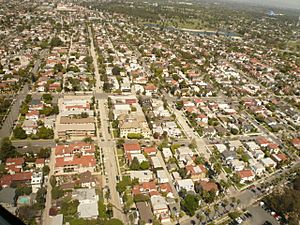
The Bembridge House, a Queen Anne Victorian house, is open for tours. Long Beach is also home to the unique Skinny House.
The Earl Burns Miller Japanese Garden is a peaceful garden on the campus of California State University, Long Beach.
You can also take fun gondolier trips through the canals of Naples.
Parks and Outdoor Fun in Long Beach
Long Beach is known for its many parks and green spaces. The city's Parks, Recreation and Marine Department has won awards for its great programs. They manage 92 parks covering over 3,100 acres (12.5 km2).

The El Dorado Regional Park is a huge park with fishing lakes, bike trails, and picnic areas. The El Dorado Nature Center within the park has trails, meadows, and forests.
Willow Springs Park is a restored wetlands area that opened in 2017. It helps protect the environment and shows the history of the area. It's becoming the largest green space in Central Long Beach.
The Long Beach Green Belt path is a walking and biking trail that used to be a railway. It's now home to many California native plants and urban wildlife.
The Los Cerritos Wetlands are being preserved to protect Long Beach's last remaining wetlands. Other natural spots include Bluff Park, Colorado Lagoon, and the Golden Shore Marine Biological Reserve.
The Municipal Fly Casting Pool at Recreation Park has been used for fly fishing since 1925. It even hosted events for the 1932 Summer Olympics.
Rosie's Dog Beach in Belmont Shore is the only beach in Los Angeles County where dogs can run off-leash.
Sports and Recreation in Long Beach
Grand Prix of Long Beach
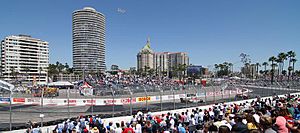
The Grand Prix of Long Beach is the biggest event in the city, held every April. It started in 1975 as a car race on the downtown streets. Now, it's an exciting IndyCar race.
The Long Beach Motorsports Walk of Fame honors important people in motorsports. It's located on South Pine Avenue near the Grand Prix track.
Long Beach Marathon
The Long Beach Marathon takes place every October. It includes a Kids Fun Run, a Bike Tour, a 5K, a Half Marathon, and a Full Marathon. All races start and end near Shoreline Village.
Baseball and Basketball
The Long Beach State Dirtbags baseball team has been playing since 1954 at Blair Field.
Long Beach was home to the Long Beach Chiefs basketball team in the 1960s. The Long Beach Jam, a minor league team, played at the Walter Pyramid from 2003 to 2005.
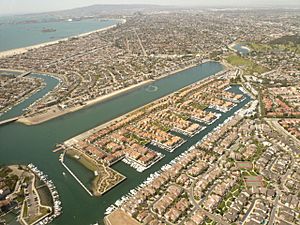
Water Sports
The Congressional Cup, an international sailing event, has been held in Long Beach since 1964. The Leeway Sailing and Aquatics Center offers youth sailing programs.
Every July, the Catalina Ski Race starts from Long Beach Harbor. Skiers race 100 km (62 miles) to Catalina Island and back.
Surfing used to be popular in Long Beach. However, a large breakwater built in 1949 now blocks most of the waves. Some people want the breakwater changed so waves can return.
College Sports
Long Beach State's sports teams are called the Beach. They have won national championships in women's volleyball, men's volleyball, and other sports.
Long Beach City College also has successful sports teams, with national championships in gymnastics and football.
The archery field in El Dorado Regional Park was used for the 1984 Los Angeles Olympics archery competition.
Long Beach and the 2028 Summer Olympics
Long Beach will host several sports during the 2028 Summer Olympics. These include BMX racing, water polo, triathlon, open water swimming, sailing, rowing, canoeing, and handball.
How Long Beach Works
City Services
The Long Beach Police Department keeps the city safe. The Long Beach Fire Department provides fire protection and emergency medical services. They have 23 fire stations and a Marine Safety Division that patrols the beaches and waterways.
Education in Long Beach
Public Schools
The Long Beach Unified School District serves most of the city. High schools in Long Beach include:
- Cabrillo High School
- Ernest McBride High School
- Jordan High School
- Long Beach Polytechnic High School
- Millikan High School
- Renaissance High School for the Arts
- Richard D. Browning High School
- Sato Academy of Mathematics and Science
- Will J. Reid High School
- Wilson High School
Colleges and Universities
Long Beach has two public colleges: California State University, Long Beach (CSULB) and Long Beach City College (LBCC).
CSULB was founded in 1949 and is known for its arts programs. LBCC, started in 1927, has two campuses.
Getting Around Long Beach
Ports and Shipping
The Port of Long Beach is one of the busiest seaports in the world. It handles a huge amount of cargo, especially between the United States and countries around the Pacific Rim.
The Long Beach Cruise Terminal is where cruise ships depart, carrying over 600,000 passengers each year. You can also take trips to Catalina Island from Catalina Landing.
Public Transportation
- Buses and Shuttles
Long Beach Transit provides bus services within Long Beach and nearby cities. Most buses start or end at the Long Beach Transit Mall in downtown.
The "Passport" is a free shuttle in downtown Long Beach. It takes passengers to popular spots like the Aquarium of the Pacific, Shoreline Village, and the Queen Mary. In the summer, you can also ride the AquaLink catamaran or the AquaBus water taxis.
- Light Rail
The LA Metro operates the Metro A Line, a light rail service. It connects downtown Long Beach to downtown Los Angeles and other cities like Pasadena. From there, you can connect to other train lines to explore more of Southern California.
Airports
Long Beach Airport serves the Long Beach area. For international flights, Los Angeles International Airport (LAX) is the closest option.
Major Roads and Highways
Several freeways run through Long Beach. The San Diego Freeway (I-405) goes through the city, connecting it to other areas. The Long Beach Freeway (I-710) is a main route from downtown Los Angeles to the Port of Long Beach.
The Pacific Coast Highway (SR 1) also runs through Long Beach, offering scenic views.
Biking and Walking
Long Beach has many bike paths, covering over 60 miles (97 km). The city is also very walkable, ranking among the most walkable cities in the world.
Media and News in Long Beach
Newspapers and Magazines
Long Beach's daily newspaper is the Long Beach Press-Telegram. It covers news for Long Beach and nearby areas.
California State University, Long Beach has a student newspaper called the Daily Forty-Niner. There are also free weekly newspapers like The Grunion Gazette that focus on different parts of the city.
Palacio Magazine is a free magazine that publishes stories in both English and Spanish.
Radio and Online News
Long Beach is part of the Los Angeles radio and TV markets. The city has a jazz and blues radio station, KKJZ, and a public radio station, KLBP.
For online news, you can find outlets like the Long Beach Post and LBReport.com.
Notable People from Long Beach
Long Beach's Sister Cities
Long Beach has special connections with cities around the world, called sister cities:
It also has friendly relations with:
 Bacolod, Philippines
Bacolod, Philippines Rosarito Beach, Mexico
Rosarito Beach, Mexico Venice, Italy
Venice, Italy
Images for kids
-
The site of Puvunga was listed on the National Register of Historic Places in 1974.
-
Don Juan Temple purchased Rancho Los Cerritos, covering modern-day Long Beach, in 1843.
-
In 1844, Juan Temple built the Casa de los Cerritos, the oldest building in Long Beach, in a Monterey Colonial style.
-
Diseño depicting Ranchos Los Alamitos, Los Cerritos, Santa Gertrudes, Los Coyotes, Las Bolsas, 1852
-
The First National Bank of Long Beach at the turn of the century
-
Ford's Long Beach Assembly in 1930
-
Worker in the Douglas Aircraft Company plant, Long Beach, 1942. Photo by Alfred T. Palmer.
-
Downtown, Shoreline Marina, and the Port of Long Beach, 2010
-
The Wrigley neighborhood
-
View of downtown from the Queen Mary at night
-
Bluff Park, and the Shoreline Pedestrian Bikepath and Belmont Veterans Memorial Pier
-
The Belmont Heights neighborhood
-
Walking trail in the El Dorado Nature Center
-
2005 Grand Prix of Long Beach, showing turn 10 and the Long Beach skyline
-
Long Beach Marine Stadium, created to host the rowing events for the 1932 Summer Olympics
-
The Long Beach Naval Shipyard and the USS David R. Ray, Tarawa, and Essex in 1993. In the background is the original Gerald Desmond Bridge.
-
Long Beach Airport with Mount San Antonio and Timber Mountain in the background
See also
 In Spanish: Long Beach (California) para niños
In Spanish: Long Beach (California) para niños


